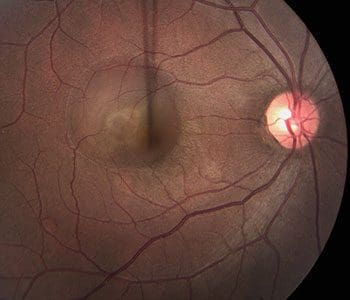
The development of fluid under the retina that results in visual distortion. As the name suggests, the collection of fluid affects central vision, where it causes the most visual disturbance.
Central serous chorioretinopathy is the development of fluid under the retina that results in blurry and distorted vision. As the name suggests, the collection of fluid affects central vision where it causes the most visual disturbance.
What are the symptoms of central serous chorioretinopathy?
Patients often complain of a blind spot, decreased or blurry vision, and distortion of shapes such that straight lines may appear bent or crooked. The vision may be minimally to significantly affected with visual acuities ranging from normal (20/20) to legal blindness.
Who gets central serous chorioretinopathy?
The disease primarily affects young adults from 20-45. Men are affected 10 times more frequently than women. Many patients with central serous chorioretinopathy are noted to be “type A personalities†or have a high level of stress. CSR can often be a side effect of the use of steroids or other hormone related medications. Inhaled, topical, oral or injected steroids are common causes of this disease.
Why does central serous chorioretinopathy occur?
The cause of central serous chorioretinopathy is thought to be due to a hormone imbalance in the layer of blood vessels behind the retina called the choroid. This imbalance leads the choroid to become leaky, and for fluid to accumulate under the retina as a result. Often reducing stress or stopping the causative medication resolves the disease without further treatment.
What is the prognosis for central serous chorioretinopathy?
Most cases of central serous chorioretinopathy (approximately 90%) will spontaneously resolve in 3 months. The remaining 10% of patients will usually require some form of treatment. Most patients maintain excellent vision. Some patients will have some residual symptoms, such as distortion, decreased color and contrast sensitivity, as well as visual difficulty at night. Despite an overall good prognosis, 40-50% of patients experience one or more recurrences.
Is there any treatment available?
Aside from stopping any offending medication, there are multiple medical therapies proven to be effective in treating central serous chorioretinopathy. Some of these medical therapies may require you to undergo a blood test to make sure the medication is safe for you to start taking. Laser treatment is sometimes recommended for tougher cases that do not respond to medication.
